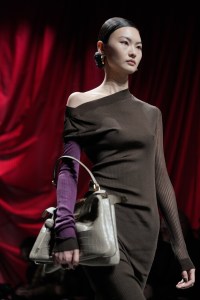MILAN — Italy’s fashion chamber on Tuesday released the final schedule for the upcoming edition of Milan Fashion Week, which runs from Sept. 17 to 23 and will feature 57 physical shows, eight digital ones and 69 presentations.
While there are no major changes compared to the provisional one released in July, the organization’s chairman Carlo Capasa took the opportunity to weigh in on the extra day the city has gained. As reported, major shows are already scheduled for Sept. 17, which historically offered a softer introduction to the event with just institutional appointments.
“It’s an important step, one that has been very difficult to secure since it impacts the international fashion calendar. We’re placed between London and Paris and we like our spot, but we need to find some space,” said Capasa, underscoring that Milan “probably has the most crowded among the fashion calendars, if you consider the ratio between the number of days and events.”
You May Also Like
He said he was “averagely satisfied” with the result, which officially sees Fendi kicking off the week at 3 p.m. CET. Unofficially, Fiorucci will stage its first runway show under the new ownership and creative direction of Francesca Murri two hours earlier at the Triennale Milano museum, which is slated to honor the brand’s late founder with an exhibition this fall.

Model on the runway at Fendi fall 2024 as part of Milan Fashion Week held on Feb. 21.
Swan Gallet for WWD
“In the future I hope we can get to start from the morning of Tuesday, not the afternoon,” Capasa said.
Yet, considering that the final day is dedicated to digital shows only and that Giorgio Armani is decamping from Milan Fashion Week to present its spring 2025 show in New York on Oct. 17 and will not close the week as it has in the past, the fashion crowd is still likely to move onto the next leg of the fashion marathon in Paris earlier, undoing the effort of securing the extra slots.
“It’s true that we will miss the Giorgio Armani show on Sunday, but it’s a one-off event and Armani is still very much present in the calendar with two Emporio Armani shows. He has never missed to show his support to Italian fashion,” Capasa said. He also underscored that many brands that this time exceptionally opted for the presentation format might return to runway shows, reiterating his belief that “we will need more and more space going forward.”

Emporio Armani fall 2024
Giovanni Giannoni/WWD
For one, Tom Ford won’t stage a runway show following the exit of its creative director Peter Hawkings and will present its spring 2025 collection in its Milan showroom on Sept. 19.
Meanwhile, Ports 1961 will embrace the same format to unveil the first collection designed by Francesco Bertolini on Sept. 21, while Brioni and MSGM, which celebrated its 15th anniversary with a coed show in June, will opt for a presentation upon appointments.
Other brands picking the format will include the likes of Giada, Maccapani and Taller Marmo as well as a plethora of emerging labels, such as Retori, Cuantico and Gio Giovanni Gerosa.
A few collaborations will be revealed in the same way, including Weekend Max Mara pairing with “Emily in Paris” actress Ashley Park and the tie-up between Max & Co. and celebrity stylist Lorenzo Posocco.
A series of milestones will be celebrated during the week, including the 50th anniversary of Iceberg, which will stage a coed show and party on Sept. 17. Laura Biagiotti will also mark 50 years since staging its first show during Milan Fashion Week, returning to a physical runway event on Sept. 21.
In addition, Redemption will mark its 10th anniversary with a show on Sept. 17, while Vogue Italia will celebrate its 60 years with an exhibition at Palazzo Citterio that will run from Sept. 19 to 21.

The advertising campaign for Milan Fashion Week, September 2024.
Courtesy of CNMI
Slightly dampening the festive mood, economic projections shared on Tuesday showed 2024 sales of the fashion and connected industries (including textiles, clothing, leather goods, footwear, jewelry, eyewear and cosmetics) are expected to decrease by 3.5 percent to 97.7 billion euros compared to 2023.
Capasa said the 6.1 percent contraction in sales in the first half of 2024 follows the slowdown the industry started to experience in the second half of last year.
While he addressed geopolitical instability as well as weak internal demand as key elements impacting the performance, he acknowledged that after COVID-19 the industry’s sales grew by double digits, a pace unlikely to be sustained in the long run.
In particular, updated figures for 2023 showed the overall sector grew 2.5 percent to reach record sales of 101.3 billion euros. In 2022 sales grew 20.8 percent to 98.8 billion euros versus 2021, when the total turnover also increased more than 20 percent.

The advertising campaign for Milan Fashion Week, September 2024.
Courtesy of CNMI
Exports continued to be a driver for the Italian fashion industry in 2023, growing 2.9 percent to 88.8 billion euros. Projections for 2024 confirm the positive trend, with exports of the overall sector expected to grow 5.5 percent to 93.7 billion euros versus 2023.
The forecast is based on the performance registered in the first five months of 2024, when exports grew 5.1 percent compared to the same period last year. Yet there’s a significant split between clusters of sectors: exports of the “core” categories — textiles, clothing, leather goods and footwear — were down 3.8 percent while those of companies operating in jewelry, eyewear and cosmetics were up 29.6 percent, boosted by the 58 percent spike reported by the jewelry sector.
